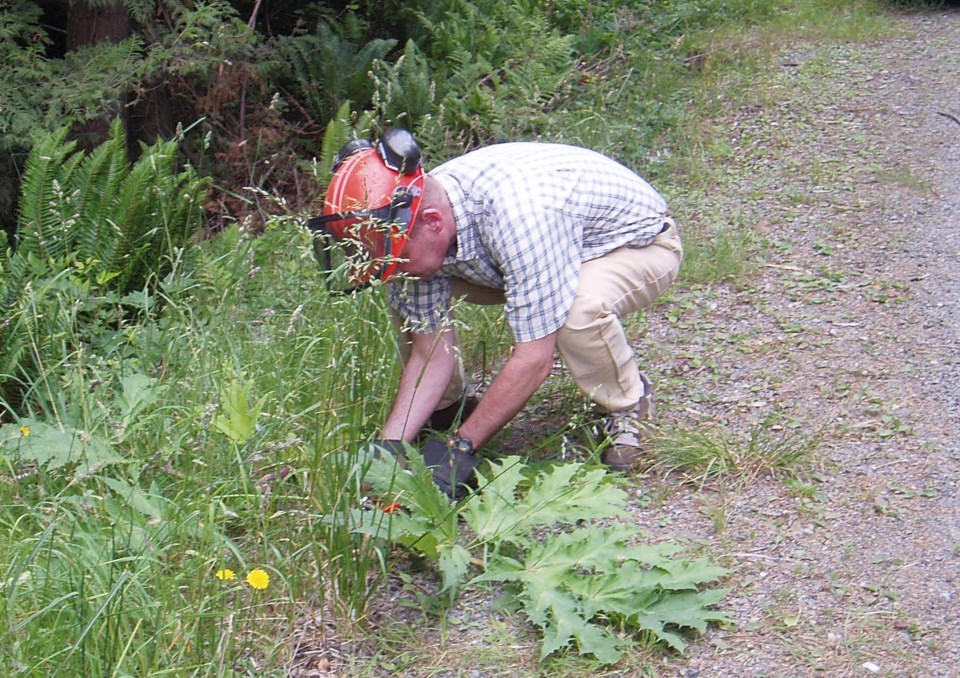Jessie Perry-Cottrell has reason to be nervous of her backyard.
The Scarborough resident learned from her downstairs neighbour, Andy Huinink, about a noxious weed growing in her backyard. A year or so ago, Huinink decided he wanted to get more use out of the yard so decided to clear away a patch of weeds. The next day, he went to work outside and developed blisters all over his arm, which had been bare when he cleared away the weeds.
Huinik learned the hard way that this plant, best known as the Giant Hogweed, has toxic, photo-sensitive sap that causes blistering, burning and sometimes permanent scars.
Perry-Cottrell says that while Huinik has covered the area he cleared with a tarp in an effort to suppress the weed, it has spread along the embankment near the property lines and is even starting to creep towards the gravel pathway to the front of the house.
Alex and Euan Sinclair, who live in a property connected tangentally to Perry-Cottrell’s yard said a guest looking through their kitchen window identified the plant and warned them about it a few weeks ago.
“She said, I’m pretty sure that’s dangerous, make sure you keep your kids away from it,” says Euan Sinclair.
Sinclair said his first course of action was to contact the Invasive Species Council of BC, but they did nothing. Next, his wife called the municipality and asked for help – but was told that they would only remove the plant from public property. So, last weekend Euan Sinclair donned a facemask, long-sleeved shirt and work gloves and cut the plant down himself.
“I have some small blisters in spots where my gloves and sleeves didn’t completely cover me up,” says Sinclair. “It’s hard to cover up properly especially when it’s so hot out.”
Parks and environment manager Bonny Brokenshire told council this week that public work crews have recently identified and destroyed Giant Hogweed plants in ditches in the Windjammer area and the Queen Charlotte Heights area; and she proposed a series of first steps in fighting back against the invasive plant.
“It’s at a state right now where we can map it, we can attack it. Unlike a lot of invasive species on Bowen, they are past the point of physically eradicating. This species is something we can tackle perhaps through education but at least we can start there,” said Brokenshire.
Brokenshire added that with large hollow stems, children have known to pretend the stems are spyglasses and develop burns around the eyes, and even blindness.
Islander Bill Granger first reported the appearance of Giant Hogweed on Bowen roughly ten years ago, having found it on Grafton Road and Adams Road. Through his work as manager of parks and environmental services in North Vancouver in the 1990s, Granger was familiar with the plant and how to deal with it.
“We found this infestation of weeds in Mosquito and Wagg Creeks running right through North Vancouver and sent work crews out to pull them out,” says Granger. “People on our crews started coming back and complaining of being itchy, and feeling burned. One person swelled up in huge boils and had to go to Lion’s Gate Hospital. At that point, we stopped trying to remove it.”
Granger says the best way to remove a Giant Hogweed plant is with a machine that will dig it out by its roots. However, he says if that is not possible, cutting off the plant’s umbel (the very top part, where it blooms) can at least help stop the plant from spreading.
“Each umbel of the bloom contains more than 1,000 seeds that spread quickly by wind or in animal fur,” says Granger. “Now would be the time to take that action, before the umbel’s bloom and the seeds start to disperse.”
He says that the plant’s most obvious feature is its size, but that it is often confused with Gunnera, another, benign plant with extremely large leaves.
The plant also has a reddish stem, and deeply grooved and divided leaves. Granger says that the plant produces toxic sap even when it is small. He adds that while the plant prefers moist conditions often found in ditches, it will grow anywhere.
Although there was some debate at Monday evening’s meeting about whether the municipality would be able to handle a potential deluge of reports about Hogweed plants across the island, council ultimately voted in favour Brokenshire’s proposal to launch a public education campaign and set up an email address for people to report sightings of the plant.
Brokenshire says that until the email address is set-up, people who have information about the location of Giant Hogweed plants should contact her directly at the Municipality. Also, she adds that the municipality will find a way to take action to remove the plants if they are found.



